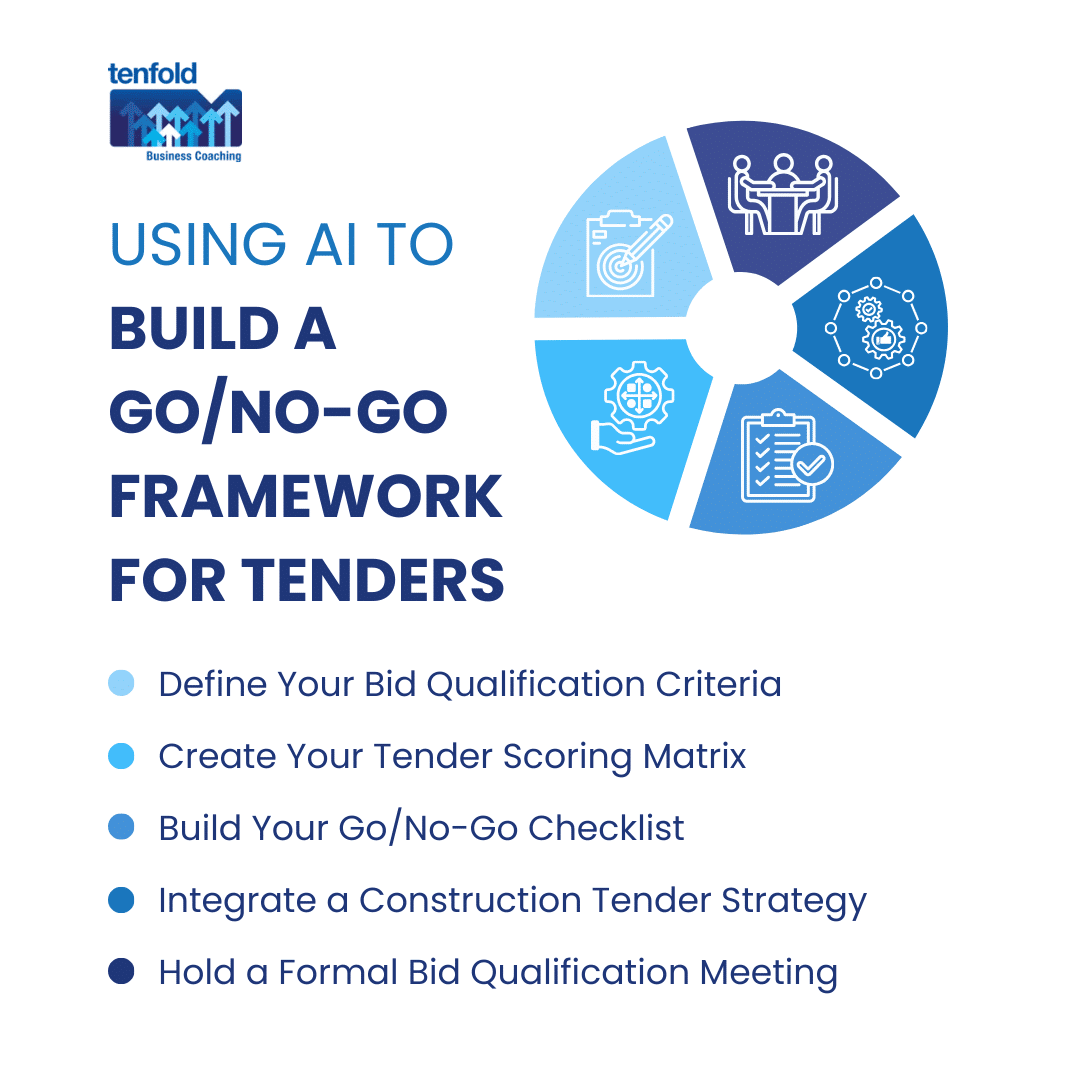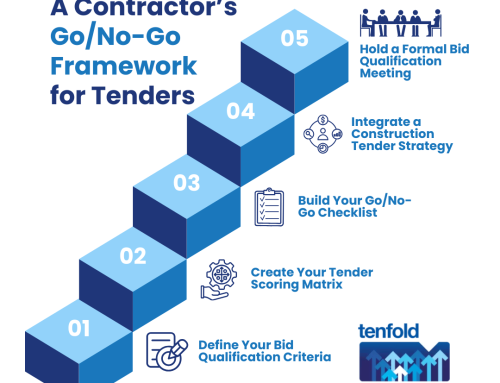AI for B2B Contractors: Use AI to Build a Go/No-Go Framework for Tenders
As a small business coach at Tenfold Business Coaching, I’ve helped countless contractors win profitable tenders with a proven go/no-go framework. In my original article “Only Bid to Win: A Contractor’s Go/No-Go Framework for Tenders”, I shared clear decision rules, scoring matrices and checklists. Today, I’ll show you how to use the free version of ChatGPT to turn each step into actionable tasks. You’ll learn simple prompts to draft criteria, build templates and reflect on your pipeline – all without complex integrations.
Why a Tender Go/No-Go Framework Matters
Every day, your business is likely to encounter numerous tender opportunities across various industries and sectors. While it can be tempting to pursue every potential deal to maximise your chances of securing new work, this approach often detracts from your core focus. Chasing after every opportunity can, in fact, erode your profit margins, stretch your resources thin, and ultimately dilute the strength and clarity of your brand in the marketplace.
To counter these risks, implementing a formal go/no-go framework is essential. Such a framework allows you to carefully evaluate each tender opportunity against your capacity, strategic goals, and long-term vision. It ensures that your team concentrates its efforts on bids that truly align with your business’s objectives, safeguarding your valuable resources and enhancing your overall capacity for success. Additionally, by focusing on the most promising opportunities, you can significantly boost your hit rate, creating a more sustainable and profitable growth trajectory for your organisation.
Step 1: Define Your Bid Qualification Criteria
You need to establish clear and well-defined thresholds for various critical aspects of your projects. These include the project’s size, the alignment of the budget with your financial goals, the project’s geographical location, the scope of technical requirements, the client’s reputation, and the strategic value the project offers to your organisation. These criteria serve as essential gatekeepers, effectively acting as decision points that determine whether a project proceeds or is halted at an early stage. By setting these thresholds, you ensure a consistent, objective, and transparent process for project evaluation and selection, helping to mitigate risks and align projects with your organisation’s strategic objectives.
How to Use ChatGPT (Free Version Only) to Implement The Advice
Seek assistance from ChatGPT to not only generate but also refine your bid qualification criteria, ensuring they are tailored to meet your specific business objectives. You can customise each threshold to align with your company’s goals and leverage your past experiences to make more informed decisions. This process helps in setting clear, attainable benchmarks that suit the unique context of your Australian business environment, ultimately supporting your team in submitting more competitive and well-qualified bids.
Example Prompts
- “Help me list bid qualification criteria for a regional builder focusing on project budget, travel distance and client payment history.”
- “Generate a table of minimum margin percentages, project sizes and strategic sectors for our go/no-go decision.”
- “Suggest questions I can use to reflect on past tenders and identify which criteria I often overlooked.”
Step 2: Create Your Tender Scoring Matrix
A scoring matrix is a valuable tool that allows you to systematically assign weights and scores to each criterion involved in a decision-making process. By doing so, it helps to remove personal biases and ensures that decisions are made based on objective and quantifiable data. This structured approach facilitates clear and fair evaluation of options, making it easier to compare different choices effectively. In the context of business or project management, you set a specific threshold score that acts as a trigger; if an option meets or exceeds this predetermined score, it is considered a suitable ‘go’ decision. Conversely, options that score below the threshold can be deemed unsuitable or require further review. Overall, implementing a scoring matrix promotes transparency, consistency, and rationality in decision-making processes, particularly in complex situations where multiple criteria need to be balanced and evaluated impartially.
How to Use ChatGPT (Free Version Only) to Implement The Advice
Utilise ChatGPT to help you draft a comprehensive matrix template, suggest appropriate weightings for each criterion, and simulate scoring examples grounded in hypothetical tender scenarios. This process can aid in making more informed decisions and enhancing your tender evaluation procedures.
Example Prompts
- “Create a tender scoring matrix template with five criteria and weightings totalling 100 per cent.”
- “Give me three examples of weighted scores for a mid-size civil tender with high client reliability but tight margins.”
- “Explain how to set a go/no-go threshold score of 3.5 out of 5 in a tender scoring matrix.”
Step 3: Build Your Go/No-Go Checklist
A comprehensive and well-structured checklist serves as an essential tool to guarantee that you do not overlook any critical factors before committing significant resources to a project or initiative. This detailed checklist should incorporate key elements such as margin thresholds, which help in assessing profitability and risk; references to prior similar projects or case studies for guidance; clear timelines to ensure timely execution; the availability of subcontractors and other essential personnel; and alignment with your strategic objectives to ensure that the project supports your long-term goals. By methodically addressing each of these aspects, you can mitigate potential risks, improve decision-making processes, and enhance the overall success rate of your ventures.
How to Use ChatGPT (Free Version Only) to Implement The Advice
Prompt ChatGPT to transform your key criteria into a well-structured and easy-to-follow formatted checklist. Additionally, you can request the inclusion of notes fields and best practices to ensure that the document remains dynamic, up-to-date, and useful over time. This approach helps in maintaining clarity and organisation, making it simpler to review and update your criteria as needed. By incorporating these elements, you can keep the document live, relevant, and a valuable resource for ongoing reference and decision-making.
Example Prompts
- “Draft a go/no-go checklist for a builder, including margin threshold, client references, timeline feasibility and subcontractor capacity.”
- “Suggest best practices for maintaining a tender checklist in a weekly pipeline meeting.”
- “Generate a notes column template for each checklist item to record Yes/No and comments.”
Step 4: Integrate a Construction Tender Strategy
Integrating your scoring matrix and checklist into the daily operational processes of your organisation significantly streamlines the pre-tender workflow. This approach enables your team to work more efficiently by implementing tactics such as engaging with clients early in the process, conducting collaborative workshops, utilising standardised templates for consistency, maintaining comprehensive risk registers to identify potential issues proactively, and establishing clear decision gates to ensure all critical points are addressed before progressing. These strategies collectively enhance overall efficiency, reduce potential delays, and support a more systematic and organised approach to managing pre-tender activities.
How to Use ChatGPT (Free Version Only) to Implement The Advice
Leverage ChatGPT to systematically outline comprehensive standard operating procedures for each specific tactic, ensuring clarity and consistency across all processes. Additionally, draft detailed email templates designed for early engagement with stakeholders and clients, tailored to suit Australian English conventions and communication styles. Furthermore, develop a versatile risk register template that can be used to identify, assess, and manage potential risks effectively within the organisation.
Example Prompts
- “Outline an SOP for holding a scope-clarification workshop with a client before a tender.”
- “Draft an email to a client contact requesting a brief scope clarification meeting.”
- “Generate a risk register template with columns for risk description, impact, likelihood and mitigation actions.”
Step 5: Hold a Formal Bid Qualification Meeting
A well-organised, structured meeting with the core team members is held to thoroughly review the scoring results obtained from the recent evaluations. During this meeting, the team carefully completes the predefined checklist to ensure all necessary aspects are covered. The discussion also encompasses an assessment of the resources available, determining whether they are sufficient for proceeding. Based on the deliberations, a collective decision is made to either proceed with the project, defer the decision for further review, or decline the opportunity altogether. All these decisions are then recorded systematically in a simple yet effective tracking system or spreadsheet to keep a clear record for future reference and accountability.
How to Use ChatGPT (Free Version Only) to Implement The Advice
Ask ChatGPT to help you prepare comprehensive meeting agendas, detailed decision-tracker templates, and sample minutes of meetings to effectively keep your team aligned and ensure everyone remains accountable. Using these tools can facilitate clearer communication, streamline your meeting processes, and contribute to a more organised and productive work environment.
Example Prompts
- “Create a bid qualification meeting agenda covering scoring review, checklist completion and final decision.”
- “Generate a decision-tracker table with columns for tender name, decision, date, owner and comments.”
- “Draft sample meeting minutes for a bid/no-bid meeting that ended with a Go decision.”
Tracking Tender Hit Rate and Margin
Logging tender submissions, wins, hit rates, and average margins on a regular basis can provide valuable insights into your operational performance. By carefully analysing this data over time, you can identify patterns and trends that might otherwise go unnoticed. This ongoing process of review and reflection allows you to make informed, strategic adjustments to your tendering framework, ultimately improving your chances of success in future submissions. Consistent monitoring and analysis not only help you understand your current performance but also enable you to develop more effective strategies tailored to the specific nuances of the Australian market.
How to Use ChatGPT (Free Version Only) to Implement The Advice
Use ChatGPT to develop a comprehensive spreadsheet template, generate detailed quarterly summary prompts, and propose various chart formats to effectively visualise emerging trends and patterns over time. This approach aims to enhance data analysis and facilitate better decision-making processes.
Example Prompts
- “Design a spreadsheet template to track month, tenders submitted, wins, hit rate and average margin.”
- “Explain how to calculate hit rate and average margin formulas in Google Sheets.”
- “Suggest three chart types to visualise tender hit rate versus average margin over six months.”
Continuous Improvement in Your Bid/No-Bid Framework
Quarterly reviews of unsuccessful tenders help identify specific areas where your scoring mechanisms or threshold levels may need adjustment to improve future success rates. Additionally, ongoing team training focused on current market trends and industry best practices ensures your team remains well-informed and agile, keeping your business ahead of competitors in a dynamic marketplace.
How to Use ChatGPT (Free Version Only) to Implement The Advice
ChatGPT can help you analyse past results, recommend weight adjustments, and draft training session outlines on emerging industry needs.
Example Prompts
- “Analyse a list of lost tenders and suggest areas where our scores were weakest.”
- “Recommend new weightings for our scoring matrix based on a shift towards larger projects.”
- “Create an outline for a team training session on current construction market trends in Australia.”
Take Charge of Your Tender Process
You now have a comprehensive and well-structured plan to use the free version of ChatGPT to thoroughly implement each and every step of my detailed go/no-go framework. This includes everything from drafting precise criteria and creating effective templates to facilitating productive meetings and diligently tracking the results. Simple prompts will serve as your guiding tools to keep your focus sharp on the bids that you can realistically win and do so profitably. As your dedicated small business coach, I am here to fully support and guide you on your growth journey, providing insights and encouragement along the way. If you’re interested in receiving personalised, one-on-one guidance on how to tailor this innovative AI-powered approach specifically to your business needs, please don’t hesitate to get in touch with Tenfold Business Coaching. We’re committed to helping your business succeed and thrive in today’s competitive landscape.






